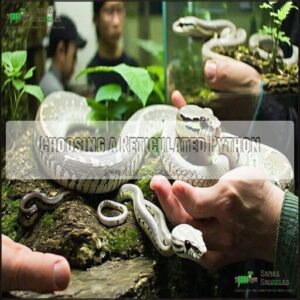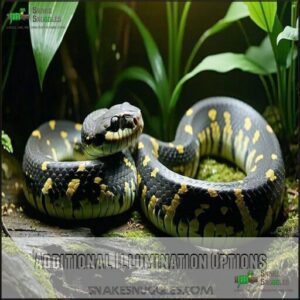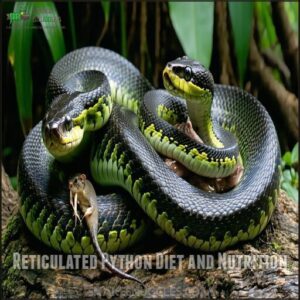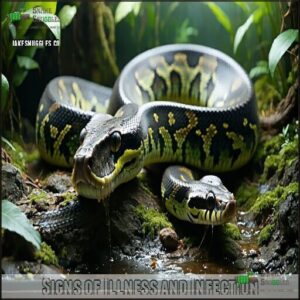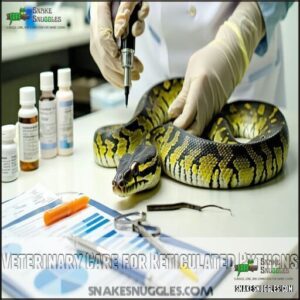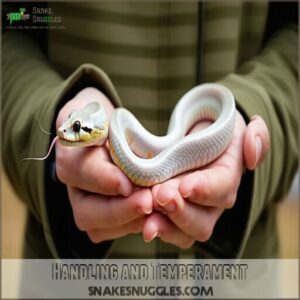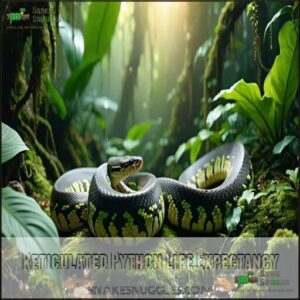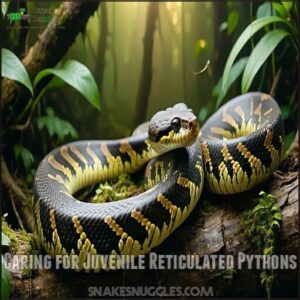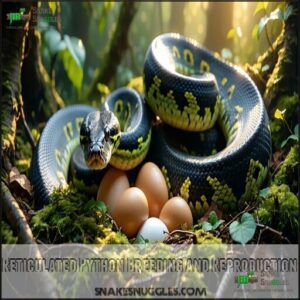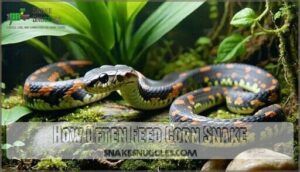This site is supported by our readers. We may earn a commission, at no cost to you, if you purchase through links.
 Reticulated pythons as pets can be fascinating but require serious dedication. These large snakes, known as one of the world’s longest species, need spacious enclosures, precise temperature and humidity control, and a secure setup to prevent escapes.
Reticulated pythons as pets can be fascinating but require serious dedication. These large snakes, known as one of the world’s longest species, need spacious enclosures, precise temperature and humidity control, and a secure setup to prevent escapes.
Their diet includes appropriately sized prey, typically fed every 1-2 weeks. Captive-bred pythons are tamer and healthier than wild-caught ones, so choose a reputable breeder.
Handling requires skill, especially as they grow, with proper techniques to guarantee safety for both you and the snake. If you’re ready for their size, long lifespan, and care demands, they can make an impressive companion.
Careful planning is essential!
Table Of Contents
- Key Takeaways
- Choosing a Reticulated Python
- Housing Your Reticulated Python
- Setting Up The Perfect Enclosure
- Reticulated Python Diet and Nutrition
- Reticulated Python Health Concerns
- Handling and Temperament
- Reticulated Python Life Expectancy
- Caring for Juvenile Reticulated Pythons
- Reticulated Python Breeding and Reproduction
- Reticulated Python Ownership and Regulations
- Frequently Asked Questions (FAQs)
- Do reticulated pythons make good pets?
- Can you own a reticulated python in the US?
- Can I keep a reticulated python?
- Can you own a reticulated python in the United States?
- Can reticulated pythons be tamed?
- Are reticulated pythons aggressive to humans?
- Can you own a reticulated python?
- Are reticulated pythons aggressive?
- Can you own a reticulated python as a pet?
- How big of a tank do you need for a reticulated python?
- Conclusion
Key Takeaways
- Choose a captive-bred reticulated python for easier handling, better health, and to support conservation efforts.
- Set up a large, secure enclosure with proper temperature, humidity, and climbing space to match their natural habitat.
- Feed appropriately sized prey every 1-2 weeks, and avoid overfeeding to prevent obesity and health issues.
- Research local laws and permits, and commit to the significant responsibilities and costs of owning such a large snake.
Choosing a Reticulated Python
When choosing a reticulated python, prioritize selecting one that matches your experience level and available resources.
Match your reticulated python choice to your expertise and resources for a rewarding and responsible ownership experience.
Consider factors like size, temperament, and whether the snake is captive-bred or wild-caught to guarantee a healthy and manageable pet, ensuring you can provide the necessary care for your reticulated python.
Things to Consider Before Buying
Before buying a reticulated python, think carefully—it’s more than just owning a snake.
These awe-inspiring reptiles demand serious dedication.
- Space Commitment: With sizes exceeding 20 feet, they need enclosures mimicking their natural environment—large, sturdy, and secure.
- Cost Analysis: Beyond the snake, budget for specialized habitats, premium diets, and veterinary care.
- Experience Level: Reticulated pythons require advanced handling skills.
Understand their temperament, unique care needs, and potential risks.
Also, check legality in your area; some places restrict ownership.
This lifelong, challenging commitment is best for seasoned reptile enthusiasts.
Differences Between Captive-Bred and Wild-Caught Snakes
When picking a reticulated python, understanding the temperament differences and health variations between captive-bred and wild-caught snakes is key.
Captive-bred pythons adapt easily, showing less stress and lower risk of snake parasites, making them healthier and more predictable pets.
In contrast, wild-caught snakes may struggle with adaptability comparison, showcasing defensive behavior and introducing potential health issues.
Ethically, choosing a captive-bred snake supports conservation impact efforts, reducing pressure on wild populations.
For a reliable companion with fewer challenges, stick with captive-bred—it’s a win for you, your snake, and the environment.
Choosing a Reputable Breeder
Finding a reputable breeder is vital for guaranteeing your reticulated python’s health and well-being.
Look for breeders with strong ethics who prioritize captive-bred lineage and transparent practices. Reputable breeders provide health guarantees, detailed genetic records, and can explain their ethical breeding methods.
Tour their facilities, and inspect both the snakes and habitats for cleanliness and proper care. Engage with breeders who enthusiastically share knowledge and prioritize snake health over profit.
- Tip: Always verify the breeder’s reputation. Seek recommendations from snake enthusiasts or herpetology groups to guarantee you’re purchasing from a trusted, respected source committed to ethical breeding and reticulated python care.
Housing Your Reticulated Python
Providing a proper enclosure for your reticulated python is essential to its health and well-being.
You’ll need to verify the tank size, temperature, humidity, and substrate meet its natural habitat needs.
Tank Size and Space Requirements
Creating the perfect reticulated python enclosure starts with proper dimensions. A cramped tank can stress your snake, so always prioritize the right snake tank length, width, and height.
| Feature | Small Pythons (6-12 ft) | Large Pythons (13+ ft) |
|---|---|---|
| Minimum Dimensions | 6x3x2 feet | 12x6x4 feet |
| Vertical Space | 2 feet | 4 feet |
| Enclosure Materials | Strong glass/wood | Reinforced materials |
| Ventilation Needs | Moderate airflow | High airflow |
| Custom Builds | Optional | Recommended |
An ideal snake enclosure size gives room for climbing and exploring. Use durable materials with secure locks, as retics are escape artists. Ventilation needs and vertical space are essential for a healthy, active python.
Humidity and Temperature Control
Humidity monitoring and maintaining proper temperature gradients are critical for your python’s well-being.
Use digital hygrometers to keep humidity between 65-85% and thermometers to track basking zones at 90-95°F with cooler areas around 75-78°F.
This balance promotes shedding, thermoregulation, and overall health.
Mist the enclosure daily, and consider humid hides or water bowls for added snake humidity.
Verify your equipment calibration is spot-on, especially with seasonal adjustments.
A stable microclimate prevents shedding issues and keeps your reticulated python comfortable year-round, thriving like it’s still in the wild.
Reticulated pythons require specific environmental conditions to remain healthy.
Substrate Options for Reticulated Pythons
When setting up your reticulated python enclosure, choosing the right snake substrate is essential for their comfort and health.
The substrate impacts humidity retention, odor control, and even your python’s digging behavior.
Consider these options:
- Cypress Mulch: Excellent for humidity retention and minimizing odor, making it ideal for tropical climates.
- Reptile Carpet: Simplifies cleaning but lacks the natural feel for burrowing.
- Bioactive Soil: Mimics the natural habitat, supports digging behavior, and promotes environmental balance.
- Aspen Shavings: Affordable and soft but may pose an impaction risk if ingested.
For various options, you can purchase cypress mulch online.
Balance your choice on factors like cost comparison, maintenance, and your reticulated python’s needs.
A proper snake substrate guarantees optimal reticulated python care while creating a safe, comfortable environment in your snake enclosure.
Setting Up The Perfect Enclosure
To set up the perfect enclosure for your reticulated python, you’ll need to replicate its natural environment with precise temperature, humidity, and space.
A well-designed habitat guarantees your snake stays healthy, active, and stress-free, which is crucial for its overall well-being, making environment a key factor.
Creating a Temperature Gradient
Creating the right temperature gradient is a cornerstone of reticulated python care. In your snake enclosure, aim for a warm basking spot on one side, maintained between 88-92°F, while the cool zone on the opposite end should stay around 78-82°F.
This setup mimics natural conditions and allows for proper thermoregulation. Use reliable heat sources, like heat lamps or ceramic heaters, and place them securely.
Remember to use monitoring tools, such as digital thermometers or temperature guns. Seasonal adjustment may be necessary to keep your snake’s habitat consistent.
- **Keep the basking spot cozy yet safe.
- **Ensure the cool zone stays comfortable.
- **Track daily temperatures for accuracy.
- **Install devices securely to avoid hazards.
Your python will thrive with balanced temperatures!
UVB Lighting for Reticulated Pythons
A proper temperature gradient helps your snake thrive, but don’t overlook UVB lighting—it’s essential for reticulated python care.
UVB lighting supports calcium absorption, vitamin D3 synthesis, and boosts your python’s overall health. Although some may survive without it, incorporating UVB into your reticulated python enclosure mimics its natural habitat, promoting better activity and appetite.
Here’s how to optimize snake lighting for reticulated python health:
- Bulb Types: Use reptile-specific UVB tubes like a D3+ 12% lamp.
- Distance Matters: Position bulbs to guarantee ideal UVB exposure (UVI 2.0–3.0) without overheating.
- Lighting Schedule: Maintain 12 hours daily, adjusting seasonally.
- Preventing Burns: Shield bulbs to avoid direct contact.
Regularly replace bulbs every 12 months to guarantee performance.
Additional Illumination Options
Lighting your reticulated python enclosure effectively enhances its well-being.
Consider these options:
- LED Options: Mimic natural light cycles using energy-efficient LEDs, offering day and night lighting.
- Infrared Lighting: Use ceramic heat emitters to maintain warmth without disturbing the snake’s nocturnal rhythms.
- Basking Bulbs: Create focused basking spots for warmth, ensuring your snake thermoregulates comfortably.
Strategic snake enclosure lighting makes a natural environment, combining snake basking bulbs, night lighting, and UVB lighting for a thriving python enclosure.
Reticulated Python Diet and Nutrition
Providing your reticulated python with the right diet is essential for its health and longevity.
You’ll need to match prey size, feeding frequency, and proper supplements to its age and size.
Feeding Prey Items and Prey Size
Feeding your reticulated python is all about customizing meals to fit its size and nutritional needs. The right prey guarantees proper growth, digestion, and overall health.
Here’s how to approach feeding with precision:
- Prey Type: Stick to feeder options like rats, rabbits, or chickens for a balanced reticulated python diet. These provide the nutrients your snake needs.
- Prey Size: Match prey to your snake’s widest body area. Too small won’t satiate it; too large risks digestive discomfort.
- Frozen vs. Live: Always choose frozen-thawed food over live prey. It’s safer, reduces stress, and avoids injuries during snake feeding.
Each meal should be a perfect synchronization of nutrition, prey size, and safety. Whether offering rats or rabbits, careful preparation guarantees your python stays healthy and well-fed without complications.
Frequency of Feedings and Avoiding Overfeeding
A consistent feeding schedule keeps your reticulated python healthy.
Match prey size to the widest part of your snake’s body to avoid complications.
Juvenile schedules focus on growth, while adult schedules slow down as metabolism adjusts.
Watch for signs of snake overfeeding—like lethargy or obesity risks—and adapt to seasonal adjustments as needed.
Prioritize balance in every meal to guarantee your python thrives.
Supplements and Vitamins
Building on the need to avoid overfeeding, you’ll also want to support your python’s diet with thoughtful use of supplements.
While whole prey provides solid python nutrition, snake supplements fill gaps that natural diets might miss.
Here are key supplement types to make:
- Calcium with Vitamin D3: Promotes healthy bones and supports metabolic processes.
- Multivitamins: Helps avoid deficiency signs like lethargy or poor shedding.
- Natural Sources: Dust prey lightly with python vitamins for an all-in-one boost.
- Dosage Guidelines: Stick to vet-approved recommendations to prevent over supplementation risks.
To find the right product, reflect on browsing a site that offers python calcium supplements.
With the right python supplements, you’ll guarantee your snake thrives with balanced nutrition, health, and well-being throughout its life.
Reticulated Python Health Concerns
Keeping your reticulated python healthy requires close attention to their environment, diet, and behavior.
Ensure your python thrives by maintaining optimal care for its habitat, nutrition, and overall well-being every single day.
By understanding common health issues and recognizing signs of illness early, you can guarantee proper care and long-term well-being.
Common Health Issues and Prevention
Feeding large prey is important, but keeping your python healthy involves more than diet.
Focus on spotting early signs of illness by maintaining its enclosure.
Below is a quick table to summarize prevention:
| Health Issue | Prevention Strategy |
|---|---|
| Respiratory Infections | Maintain precise temperatures |
| Scale Rot | Keep substrate clean |
| Parasite Control | Quarantine new snakes |
| Mouth Rot | Confirm proper hydration |
| Obesity Prevention | Limit overfeeding |
This approach helps in preventing illnesses and ensures your python stays healthy by following these prevention strategies.
Signs of Illness and Infection
When reticulated pythons get sick, they show clear warning signs. Be alert to changes in their behavior, appetite, or appearance.
Watch for trouble like wheezing, open-mouth breathing, or mucus discharge, as these could indicate Respiratory Distress or Pneumonia.
- Lethargy or unexpected inactivity
- Appetite Loss and refusal to eat
- Abnormal Shedding, such as stuck or incomplete skin
Inspect for Scale Rot, infections, or signs of Snake Mites.
Crusty eyes, labored breathing, or sudden weight loss might suggest serious issues like Snake Inclusion Body Disease.
Catching these problems early is the key to saving your snake’s health. Stay vigilant.
Veterinary Care for Reticulated Pythons
If your reticulated python shows signs of illness, it’s time to involve reptile veterinarians skilled in snake veterinary care. Proactive planning guarantees better health outcomes, so don’t wait for issues to arise. Preventative care and regular check-ups are key to keeping your python in top shape.
Schedule yearly exams to catch problems like snake respiratory issues, parasitic infestations, or skin disorders early. Fecal tests can help detect parasites, while a thorough health screening checks for broader concerns. Prepare for unexpected health needs to avoid anesthesia risks during emergency treatments.
Retics require specific diets, so be sure to supplement with vitamins for peak health.
Here’s how to stay prepared:
- Locate a reliable reptile vet early
- Budget for annual and emergency care
- Learn proper quarantine and cleaning practices
- Schedule fecal exams for parasite control
- Keep an emergency protocol list handy
Consistent, preventative care protects your python’s well-being and guarantees a long, healthy life.
Handling and Temperament
Understanding your reticulated python’s temperament is essential for safe and enjoyable handling.
Proper techniques and consistent interactions can help build trust and reduce stress for both you and the snake, which is a complete concept in snake handling.
Are Reticulated Pythons Aggressive?
Reticulated python temperament varies but isn’t inherently aggressive; defensive behaviors arise from stress or poor handling.
Their strong feeding instinct might seem intimidating, but consistent training helps, and understanding temperament factors, like safe handling and minimizing stress, reduces risks of reticulated python biting.
With regular interaction, these snakes become manageable, showcasing positive training potential and balanced snake temperament over time.
Handling Techniques and Safety Precautions
Handling a reticulated python safely requires focus and respect for their size and strength.
These snakes are powerful constrictors, so understanding how to manage them is vital for both your safety and theirs.
When handling, stay calm and predictable.
Use a snake hook for the initial contact to gauge their mood and avoid startling them.
Always support their entire body, distributing their weight evenly.
Improper support can stress the snake.
Never grab or squeeze; this may trigger defensive behavior.
Here are practical tips for safe handling:
- **Move calmly and predictably.
- **Use a hook for initial interaction.
- **Support the body fully during handling.
- **Avoid handling if the snake seems agitated.
- **Stay alert to the snake’s reactions.
With proper techniques, you’ll reduce risks of injuries, bites, or harm.
Stay confident, follow safe restraint practices, and guarantee snake safety while handling.
Taming and Socialization
Trust building with your reticulated python takes consistent interaction and planning.
Start with early handling in short sessions, letting the snake feel secure.
Avoid sudden movements or tight grips.
Positive reinforcement helps reduce stress and improve snake behavior.
Support its entire body and respect its temperament.
| Key Aspect | Action | Purpose |
|---|---|---|
| Handling Basics | Support full body gently | Enhances snake comfort |
| Interaction Timing | Short, regular sessions | Builds snake tolerance |
| Positive Reinforcement | Calm handling methods | Promotes trust building |
The table outlines key aspects of snake handling, including Handling Basics, Interaction Timing, and Positive Reinforcement, to ensure a strong bond with your pet.
Reticulated Python Life Expectancy
When kept in ideal conditions, reticulated pythons can live 15 to 30 years in captivity.
Proper care, including a balanced diet and a well-maintained environment, plays a critical role in maximizing their lifespan.
Average Lifespan in Captivity
In captivity, your python can surpass wild lifespans, thriving up to 25 years with the right care.
Success hinges on habitat quality, diet, and steady health oversight. Think beyond feeding—each factor shapes the snake’s future.
Retics require enclosures that match their length; adequate ventilation is essential for their well-being.
- Snake Lifespan Tip: Invest in routine vet access and excellent husbandry practices. These simple measures can secure your reticulated python lifespan’s full potential.
Factors Affecting Lifespan and Longevity
Your python’s longevity depends on factors like genetic predisposition, diet quality, and stress reduction.
A spacious enclosure matching their natural needs, consistent temperatures, and proper humidity keep their environment healthy.
Regular veterinary access guarantees snake health is prioritized.
Captive pythons tend to outlive wild-caught ones, as controlled care boosts their python lifespan.
Balanced nutrition and attentive maintenance are key to enhancing your snake lifespan.
Health Issues Affecting Lifespan
Proactive care guarantees your reticulated python thrives. Monitor common snake health problems, as neglect can substantially shorten lifespan.
Watch for skin infections, metabolic disorders, and snake respiratory issues—these are red flags for poor husbandry impact. Control obesity risks by avoiding overfeeding and provide precise temperature regulation to prevent snake health problems like respiratory disease.
Regular veterinary care for parasite control and screening for genetic disorders is essential.
- Tip: Spot-clean your python’s enclosure daily to reduce parasite risks.
Early detection and professional snake veterinary care can make all the difference in your python’s health.
Caring for Juvenile Reticulated Pythons
Caring for juvenile reticulated pythons requires careful attention to their enclosure, diet, and handling to guarantee proper growth and health.
You’ll need to provide the right environment and feeding schedule to support their rapid development while establishing safe handling practices.
Housing and Feeding Requirements
Designing the perfect habitat is essential for juvenile reticulated python care. A 20-gallon enclosure with secure locks guarantees safety and comfort.
Prioritize proper ventilation, temperature gradients, and humidity levels to mimic their natural environment. Use cypress mulch as substrate for hygiene and moisture control.
Always include a fresh water bowl for hydration and enrichment. Smart snake feeding involves sticking to feeding schedules—offer appropriately-sized prey every 7-10 days.
Introducing prey variety guarantees balanced growth and nutrition.
| Feature | Specification | Importance |
|---|---|---|
| Enclosure Size | 20 gallons | Matches growth needs |
| Substrate | Cypress mulch | Maintains humidity |
| Ventilation | Adequate airflow | Prevents respiratory issues |
| Temperature Gradient | 80°F – 92°F | Supports digestion |
| Feeding Schedules | Every 7-10 days | Guarantees proper nutrition |
Growth Rate and Shedding
Shedding marks a juvenile reticulated python’s exciting growth journey, reflecting its health and development.
Frequent molting, especially during growth spurts, depends on proper diet, enclosure size, and balanced humidity levels (50-70%).
Adequate hydration guarantees smooth snake shedding, preventing stuck skin or stress. Monitor the snake’s growth rate, adjusting humidity and offering a moisture box if needed.
Enhanced nutrition directly impacts both reticulated python shedding frequency and python size, making it vital to align care practices with your snake’s rapid transformation.
- Tip: Increase humidity to 80% during shedding cycles.
Handling and Socialization
Building trust with your reticulated python starts with safe handling and reading its temperament.
Use gentle, steady movements while supporting its body. A snake hook can aid initial interactions, reducing stress and ensuring control.
Positive reinforcement, like consistent handling sessions, fosters familiarity. Recognizing cues—like defensive postures—helps prevent bites.
Let it explore your hands calmly, promoting snake trust and taming over time. Always prioritize its comfort, balancing your confidence with patience during each snake handling session.
Reticulated Python Breeding and Reproduction
Breeding reticulated pythons requires careful planning and a thorough understanding of their reproductive needs.
You’ll need to monitor factors like age, breeding readiness, and incubation conditions to guarantee healthy outcomes.
Breeding Age and Sexing
Once your reticulated python reaches sexual maturity, you can explore its breeding potential. Males typically mature by 18 months or around 10 feet long, while females are ready at about 3 years or 14 feet.
The breeding season peaks in February and March, aligning with natural snake hormones.
To determine sex, observe:
- Tail Shape: Males have thicker tails, where hemipenes are housed.
- Size Differences: Females grow larger, better suited for egg-laying.
- Behavioral Cues: Males often exhibit more active behaviors during the breeding season.
For accuracy, genetic testing supplements these sexing methods and aids in planning reticulated python breeding.
Mating and Egg-Laying
During the snake breeding season, introduce healthy reticulated pythons into a well-regulated environment to stimulate natural snake hormones and promote courtship.
Females tend to lay clutch sizes of 10-60 eggs. Provide a nesting area with proper humidity and warmth, mimicking their natural habitat to support egg-laying behavior.
Creating these snake breeding conditions enhances genetic diversity and guarantees successful reproduction. Pheromones aid attraction during these encounters.
Monitor the female’s health to maintain her strength during this critical phase.
Incubation and Hatching
To guarantee proper snake incubation, maintain an egg environment at 88-90°F and 90% humidity using reliable incubation methods.
Monitor conditions carefully, as genetic mutations can affect development. Snake hatchlings typically emerge after 54-60 days.
For successful breeding, track progress and adjust humidity control as needed to prevent dehydration or mold.
- Pro Tip: Consistent humidity and temperature guarantee healthy snake egglaying and hatchling care!
Reticulated Python Ownership and Regulations
Owning a reticulated python requires understanding local regulations, as many areas have strict laws regarding exotic pets.
You’ll need to research permits or licenses required in your region and confirm you can meet the long-term responsibility of caring for such a large, powerful snake, which is a significant responsibility.
Laws and Regulations Surrounding Ownership
How do you verify you’re fully compliant with reticulated python legality? Start by researching local ordinances, as python regulations can dramatically vary.
Some areas enforce exotic pet bans, while others require specific python permits. Check your state’s snake legal ownership laws, especially regarding interstate transport or restrictions on large constrictors.
Be aware of liability insurance requirements to cover potential risks. Understanding python laws also guarantees compliance with global treaties like CITES.
Before investing in your pet, consult wildlife agencies about permit requirements to avoid legal troubles. These snakes possess heat-sensing pits to detect prey.
A thorough check avoids headaches—and hefty fines—in the future.
Permits and Licenses Required
Understanding python regulations is key to reticulated python legality.
State regulations, local ordinances, and federal laws often dictate what’s required for python ownership, including exotic permits and insurance requirements.
To keep your snake legal, follow these steps:
- Check Local Ordinances: Some areas ban or limit large snake species.
- Review State Regulations: States may require exotic permits or licenses.
- Understand Federal Laws: Federal protections may apply to native habitats.
- Contact Authorities: Wildlife departments clarify python permits and costs.
Legal ownership guarantees your python is both safe and compliant with existing python laws.
Long-Term Commitment and Responsibility
Owning a reticulated python isn’t just a hobby; it’s a long-term responsibility requiring dedication.
These large pet snakes can live for 20-30 years, making them a decades-long commitment.
Here’s what to keep in mind:
- Financial Burden: Housing, food, and vet care for such a snake aren’t cheap.
- Space Constraints: They need enclosures matching their massive size.
- Ethical Considerations: Responsible ownership means meeting their complex needs.
- Relocation Challenges: Moving with or rehoming a reticulated python isn’t simple or quick.
Frequently Asked Questions (FAQs)
Do reticulated pythons make good pets?
Imagine handling a 20-foot beauty like Medusa, the longest reticulated python on record.
These snakes can make fascinating pets for experienced handlers, but their size, strength, and complex needs demand commitment and expertise.
Can you own a reticulated python in the US?
You can own a reticulated python in the U.S., but state and local laws vary widely.
Some areas require permits, while others ban them outright.
Always check your local regulations before bringing one home.
Can I keep a reticulated python?
Keeping a reticulated python isn’t for the faint-hearted.
These majestic giants require enormous enclosures, a precise environment, and experienced handling.
If you’ve got the space, dedication, and expertise, they can be incredible companions.
Can you own a reticulated python in the United States?
You can legally own a reticulated python in many U.S. states, but specific regulations vary.
Check local laws and permits since some areas classify them as restricted or require experience and secure enclosures for ownership.
Can reticulated pythons be tamed?
A reticulated python, capable of reaching over 20 feet, can be tamed with consistent, gentle handling.
Building trust takes time, and patience is key.
Always respect their natural instincts, as they remain powerful constrictors.
Are reticulated pythons aggressive to humans?
Reticulated pythons aren’t typically aggressive to humans, but their size and strength demand respect.
Most conflicts arise from improper handling or care.
Proper training and respecting their boundaries reduce risks, making them manageable for experienced keepers, which requires proper handling.
Can you own a reticulated python?
Ponder python possibilities! Owning a reticulated python is legal in many places, but laws vary.
You’ll need ample space, proper knowledge, and experience since they’re massive, powerful snakes requiring specific care and responsible handling.
Are reticulated pythons aggressive?
They’re not naturally aggressive, but they can defend themselves if they feel threatened.
Proper handling reduces stress and the chance of bites.
They’re powerful constrictors, so confidence and experience are key when managing them.
Can you own a reticulated python as a pet?
Owning a reticulated python is possible if you’re experienced and ready to handle their size and needs.
With proper care, secure enclosures, and respect for their power, they can thrive as fascinating pets.
How big of a tank do you need for a reticulated python?
You’ll need a tank at least as long as your python, ideally 8x4x4 feet or larger.
Make certain it’s sturdy, secure, and equipped with proper heating, humidity controls, hiding spots, and climbing areas.
Conclusion
Reticulated pythons, reaching lengths of over 20 feet, are impressive but require serious commitment.
Their care involves managing large, secure enclosures with precise temperature and humidity control. Feeding properly sized prey every 1-2 weeks and regular health monitoring are vital.
Captive-bred snakes are preferable for easier handling and better health.
Legal research and proper preparation guarantee a safe, fulfilling experience. With dedication, reticulated pythons as pets can be rewarding, but they’re not suitable for everyone.
- https://www.guinnessworldrecords.com/world-records/longest-snake-ever-(captivity)
- https://pdfs.semanticscholar.org/71fb/7c2e31619a2628a39b1835c6cd2296bf226f.pdf?_ga=2.164999167.1148642187.1584854979-1472862363.1584854979
- http://beruangmadu.org/uploads/pdfs/python_sun_bear_predation.pdf
- https://www.anapsid.org/handling.html
- https://animaldiversity.org/accounts/Python_reticulatus/

